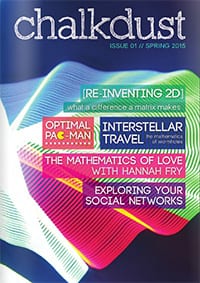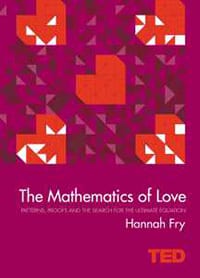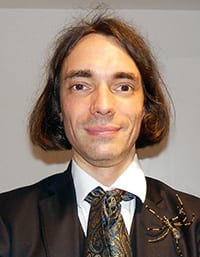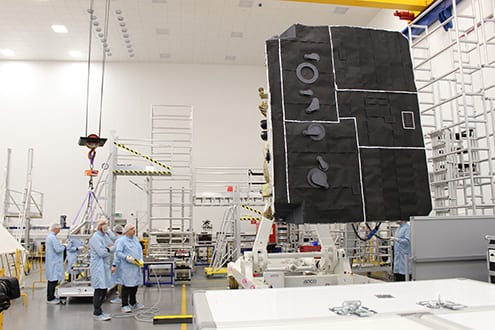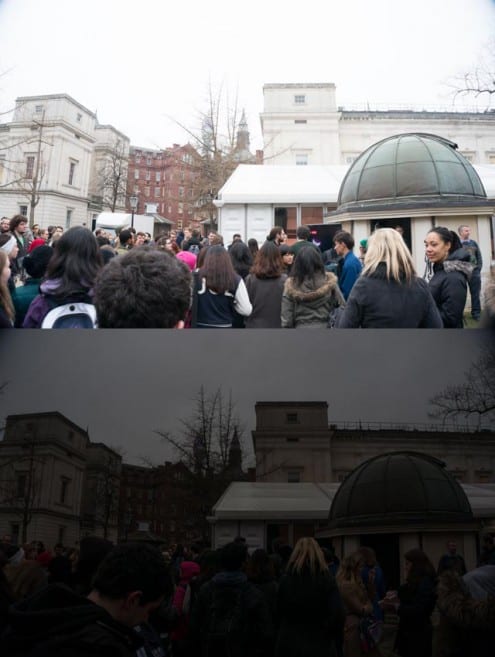This month we interviewed Professor Jem Hebden who is Professor of Biomedical Optics and Head of the Department of Medical Physics & Biomedical Engineering, UCL. We asked him ten questions around his research, career and personal life and here is what Jem replied…
UCL’s science with the Hubble Space Telescope
By Oli Usher, on 22 April 2015
This is the second in a series of posts marking the 25th anniversary of the Hubble Space Telescope. Read the first here.
UCL astronomers have been involved with the full range of Hubble science over the years.
Here are just a few highlights.
Detecting the first organic molecule on an extrasolar planet

Artist’s impression of HD 189733b passing in front of its star. The small amount of starlight that passes through the planet’s atmosphere carries with it the fingerprint of the gases present there. Credit: ESA/Hubble (Martin Kornmesser)
In 2008, a team including UCL’s Giovanna Tinetti (now working on the proposed Twinkle mission) made the first detection of an organic molecule on a planet outside the Solar System, using Hubble. Organic molecules – ones based on carbon – are thought to play a key role in the emergence of complex chemistry and the appearance of life.
Although this planet, known as HD 189733b, is so hot that it is almost certainly sterile, the team proved it has traces of methane in its atmosphere. This shows not only that organic molecules exist outside our Solar System, but that they can be detected from Earth – and that one day we might detect signs of life on another planet using the same methods.
Hubble observed the light coming from HD 189733b’s parent star as the planet passed between Hubble and the star. The gases in the atmosphere leave a faint fingerprint in the light that passes through the atmosphere, letting the scientists deduce what gases were present.
Understanding the superwinds of Messier 82

Composite image of Hubble and WIYN observations of M 82. Credit: Mark Westmoquette (University College London), Jay Gallagher (University of Wisconsin-Madison), Linda Smith (University College London), WIYN//NSF, NASA/ESA
Messier 82 (or M 82 for short) is a peculiar-looking galaxy – in the news last year thanks to a UCL lecturer and his students discovering a bright supernova there. It is in the midst of a sustained period of star formation known to astronomers as a ‘starburst’ – and this has dramatic effects on the appearance of the galaxy. It shines brightly with bright blue newly-formed stars, with noticeable regions of disrupted gas and dust clouds. It is an easy and popular target for amateur astronomers to find with mid-sized telescopes.
But the most dramatic aspect of M 82’s appearance has to be the powerul winds of glowing gas ejected out of the galaxy.
In 2004, a team of scientists including Linda Smith and Mark Westmoquette (both then at UCL) used archival Hubble images, alongside images from the WIYN telescope, to trace these ‘superwinds’. They found multiple streams of gas expanding at different rates, creating a shower of hot gas expelled from the galaxy. Some of these were travelling at more than a million miles per hour.
The team believes that the burst of star formation was triggered by a near-miss with nearby spiral galaxy M 81, which disrupted the gas clouds in M 82.
Probing the dark universe using galaxy clusters
The discovery of the accelerating expansion of the Universe was one of the most startling scientific breakthroughs of the past century. Astronomers had long known that the universe was expanding, but assumed that this expansion was gradually slowing over time. Instead, in 1998, two teams of astronomers discovered that the universe’s expansion is speeding up, with an unknown force they call dark energy driving it.
The amount of energy involved in this mysterious process is enormous – calculations show it makes up around three quarters of the total mass and energy content of the universe. This is on top of dark matter – matter whose gravity can be seen, but which is totally invisible to telescopes – which also outweighs all the ordinary matter in the universe. This means that the matter we can actually see – stars, planets, nebulae, dust clouds, galaxies – only makes up about one part in 20 of the whole universe. The rest is dark; it neither emits, reflects nor absorbs light.
A team of astronomers including UCL’s Ofer Lahav proposed to carry out a huge programme of observations called the Cluster Lensing and Supernova Survey with Hubble (CLASH), in order to gather as much data as possible about the mysteries of the dark universe.
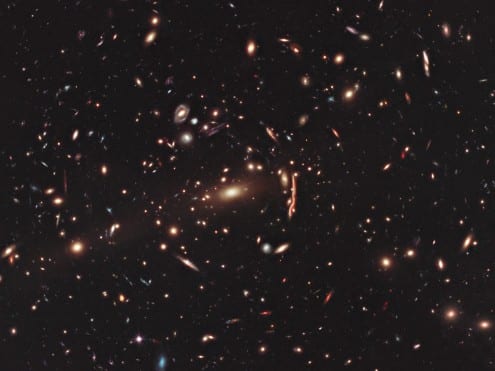
Cluster MACSJ1206, one of 25 observed by the CLASH programme. The distorted, magnified shapes of background galaxies can be faintly seen in the image. Credit: NASA, ESA, the CLASH team and Marc Postman
Between 2010 and 2013, the survey made detailed images of 25 massive galaxy clusters. These clusters, which are among the largest structures in the universe, have so much gravity – largely thanks to the dark matter they contain – that they warp space-time. This means that they bend the path of light that passes through them, in a similar way to a lens.
The lensing of light reveals the location of dark matter, which is otherwise invisible. It also amplifies the light coming from galaxies in the background, enabling astronomers to see distant supernovae that would otherwise be too faint to observe. The apparent brightness of these supernovae is one of astronomers’ key tools for measuring the expansion rate of the universe, and hence the nature of dark energy.
UCL’s work in CLASH has focused on ‘photometric redshifts’, a means of deducing the distance of faraway galaxies from the colour profile they have. This work was led by Ofer Lahav, along with researchers Stephanie Jouvel and Ole Host.
On Friday, the UCL Science blog will explain what comes next for the ageing space telescope – and how UCL is helping to build its successor.
Happy birthday Hubble
By Oli Usher, on 20 April 2015
This week marks the NASA/ESA Hubble Space Telescope’s 25th birthday. Since its launch on 24 April 1990, it has revolutionised astronomy, playing a role in huge scientific events including the first images of exoplanets and the measurement of the rate of expansion of the universe.
Along the way, it has taken stunning, sharp images of space that are now icons of popular culture.
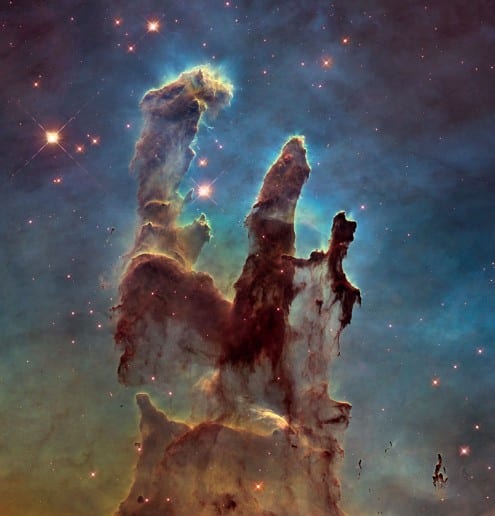
One of Hubble’s famous images, the ‘Pillars of Creation’ in the Eagle Nebula. Credit: NASA, ESA and the Hubble Heritage Team
At 25, the telescope has lasted far longer than was ever planned. But thanks to regular servicing over the years, most recently in 2009, NASA’s engineers calculate the telescope still has a few years of operation left before its hardware begins to wear out. It should even last long enough to see the first few years of operations of its successor, the James Webb Space Telescope, which launches in 2018.
Hubble had a long and difficult gestation – the idea dates back to the 1940s, with design work beginning in the ‘70s. By the early 1980s, amid rising costs and political controversy, it was clear that the US couldn’t deliver Hubble alone, so the European Space Agency was brought in as a partner.
Since then, Hubble has been an international project, with staff from around the world working on the telescope, and observing time awarded to astronomers from around the world in annual competitions. Among them have been a fair few from UCL.
Hubble science comes in different flavours.
Most of the telescope’s time is devoted to observations carried out on behalf of small teams of astronomers. If their proposal is considered to be scientifically interesting, they will get to observe their chosen targets and use the data for their research. After a year, the data is uploaded to an online archive for anyone – other scientists, or even members of the public – to view. Surprisingly, perhaps, these archival observations are still incredibly useful, and they end up being used in huge numbers of studies, often making important discoveries that are totally unrelated to the original plan.
As well as these small projects, a proportion of Hubble’s time is set aside for bigger projects. These might be a systematic survey of dozens of galaxy clusters, or a highly detailed map of a large, nearby galaxy. These surveys are carried out in order to create large, comprehensive archives that can be used for a wide range of different scientific goals.
UCL astronomers have been involved with the full range of Hubble science over the years.
On Wednesday, the UCL Science blog will cover a few of the research highlights from UCL’s work with Hubble over the years.
10 Questions
By ucqndko, on 20 April 2015
The Institute of Biomedical Engineering (IBME) interviews our researchers, academics, students, clinicians, affiliates and partners to find out a little more about who they are and what they do.
 1) What is your job title?
1) What is your job title?
Head of Department, UCL Department of Medical Physics & Biomedical Engineering.
2) How long have you been Head of Department?
Since October 2008.
3) What keywords would you pick to describe your work?
‘Challenging’ and ‘rewarding’. When I started, other heads of department warned me that it is a job which gets more difficult over time, although no-one knows why. And they were right.
4) What brought you to the world of science?
I am of the generation that was inspired towards science by the Apollo moon landings. Like many other small children in 1969, I wanted to be an astronaut and go to the moon. I still do.
5) What is the most satisfying aspect of your work?
It is highly rewarding to be involved in research which has the potential to make a lasting, positive difference to people’s health and wellbeing. As a head of department, I also derive great satisfaction from being able to help students and early-career researchers launch their own careers.
6) What do you least enjoy about your work?
The least attractive aspect of working in academia is the obsession with measuring, assessing, and reporting performance, which is totally uncreative work (e.g. REF, IQR, etc.).
7) What’s been your career highlights?
During the early part of my career as an astronomer working in Arizona, I held the world record for generating the highest spatial resolution optical image of a star. Sadly my record has since been beaten. More recently, I am very proud of my team’s achievement of the first 3D optical images of functional activity in the infant brain.
8) Who has been your greatest mentor and why?
The person who had greatest influence on my approach to life is my father, a Yorkshireman and schoolteacher who treated those imposters triumph and disaster with equal contempt. He neither condemned failure nor praised success; to him the only crime was not having a go.
9) What do you do in your spare time?
Spare time? Oh yes, I remember that. I attend a monthly art class (painting and drawing), and I occasionally play my guitar while watching Newsnight. I also read a lot of books.
10) What are your favourite books at the moment?
I recommend everyone should read Paul Broks’ unsettling and profound essay on identity and consciousness entitled “To be two or not to be” in the book Into the Silent Land: Travels in Neuropsychology. Meanwhile, two novels which I discovered and enjoyed recently are Death and the Penguin by Andrey Kurkov (about an obituary writer and his pet) and The House on the Strand by Daphne du Maurier (about drug-induced time-travel).
Jem Hebden, Professor of Biomedical Optics and Head of the Department of Medical Physics & Biomedical Engineering, leads a research group developing diffuse optical imaging technology, primarily for diagnosing neuropathology in the newborn infant brain.
First dark matter map from DES
By Oli Usher, on 14 April 2015

The first dark matter map to come out of the Dark Energy Survey. Credit: Fermilab/Dark Energy Survey
The Dark Energy Survey, an international collaboration to probe the history, evolution and large-scale structure of the cosmos, has produced its first dark matter map. Dark matter is a transparent form of matter that is distributed in vast filaments throughout the known universe. Galaxies are located along these structures, and galaxy clusters lie where they meet. Because dark matter is fully transparent, it cannot be observed directly – its presence must be inferred from the gravitational effects it has on light, in particular, the way it distorts the shape of galaxies which lie in the background.
The map is the first of a series of dark matter maps that will be published by the survey team, and is part of a batch of research that is being released to coincide with the April meeting of the American Physical Society this week.
UCL is heavily involved with the Dark Energy Survey, and has several researchers involved in the newly-published research. The university is also involved in the project through the scientific instrumentation (UCL built some of the lenses that are used by the Dark Energy Camera), and UCL’s Ofer Lahav is co-chair of the DES science board.
Related links
Art meets space
By Oli Usher, on 6 April 2015
UCL’s Mullard Space Science Laboratory has hosted a group of postgraduate Fine Art students from UCL’s Slade School. The students set up sculptures in the laboratory’s parkland campus in rural Surrey, inspired by the laboratory’s grounds and research.
Observing the eclipse in Svalbard
By Oli Usher, on 1 April 2015

The observatory during the solar eclipse. Photo: : Noora Partamies / Kjell Henriksen Observatory, The University Centre in Svalbard (free for non-commercial use)
The eclipse might have been underwhelming in London. But in Svalbard, a Norwegian archipelago far north of the Arctic Circle, the skies were clear, and the eclipse was total. Sitting on a hillside ten kilometres outside Longyearbyen – the northernmost town in the world – is Kjell Henriksen Observatory.
UCL’s Atmospheric Physics Laboratory has instruments at the observatory – and during the eclipse, three UCL scientists (Anasuya Aruliah, Ian McWhirter and PhD student Amy Ronksley) operated them remotely from overcast London.
The instruments study the properties of the uppermost reaches of the Earth’s atmosphere. Near the north and south magnetic poles, Earth’s magnetic field plunges into the atmosphere. The charged particles of the solar wind which are deflected before reaching the atmosphere in the rest of the world are able to interact with atmospheric gases here.
These interactions lead to the phenomenon known as the aurora borealis – or northern lights – and their southern counterparts.

Aurora observed from the observatory during night-time hours on 6 January. Credit: UCL Atmospheric Physics Group (CC-BY)
UCL’s instruments at the observatory measure winds and temperatures at an altitude of 240km, where the air is only one ten billionth the density of that at ground level. They do this by detecting the wind’s effect on the aurora.
The two main components of the aurora are green light, produced at an altitude of 90km, and red light, at 240km altitude. Both come from oxygen atoms whose electrons have been excited by the solar wind. As the electrons return to their usual orbits, they produce light of extremely precisely defined colours – much like neon signs or lasers do.
These colours let the scientists determine the speed and temperature of the gases in the upper atmosphere.
They determine the speed by observing how the colour shifts almost imperceptibly towards blue or red, when the wind is blowing towards or away from the observatory. (This phenomenon, known as the Doppler Effect, is also what causes the shift in the pitch of an ambulance siren as it drives past.)
They determine the temperature thanks to the oxygen atoms’ vibration. As the atoms vibrate to and fro, a miniature Doppler Effect makes the light appear slightly redder for the time the atom is moving away, and slightly bluer for the time it is moving towards the observer. This means the light is no longer a perfectly pure shade of red, but encompasses a tiny range of colours – a process known as spectral broadening. The hotter a gas is, the greater the movement, and the greater the spread of colours.
By measuring Doppler shifts and spectral broadening, the UCL instruments produce a complete weather map for the atmosphere at the edge of space.
Alongside the instruments is a colour camera with a fisheye lens, which can see from horizon to horizon, and which produces photos such as the one shown above.
Such measurements can only be done at night, not just because the auroral emissions are swamped by sunlight during the day, but because the sensitive cameras in the instruments would be damaged by sunlight. The eclipse provided a unique, albeit brief opportunity to observe during daytime. Preliminary analysis of the data has indicated strong daytime winds in the upper atmosphere during totality.
And although the scientists weren’t able to see the aurorae they hoped to catch a glimpse of, a fisheye picture they took during the eclipse does show how a small ‘umbrella’ of darkness sat directly above Svalbard, while bright sunlight was visible on the horizon in all directions.

The sky above the observatory during the eclipse – a ring of sunlight can be seen around the horizon. Photo: UCL Atmospheric Physics Group (CC-BY)
As well as simple scientific curiosity, scientists study the uppermost reaches of the atmosphere (known as the thermosphere) for some very practical reasons. Most satellites orbit within this region, and better data on its properties can help engineers plan their orbital corrections and manoeuvres. Moreover, the interaction between the thermosphere and the solar wind is also a key element of ‘space weather’, which can disrupt electrical and communications infrastructure on the ground.
The information gathered by atmospheric physicists at UCL and elsewhere is helping to improve the computer models of how the upper atmosphere behaves, so that we can better understand these phenomena.
Related links:
- Reports from the team on the UCL Astrophysics Group website
- Kjell Henriksen Observatory on Facebook
- University Centre in Svalbard
In conversation with Hannah Fry
By zcahe91, on 30 March 2015
The Dark Matter of Gravitational Lensing
By ucastdk, on 27 March 2015
Hello, I’m Tom Kitching, a cosmologist at UCL’s Mullard Space Science Laboratory. My research involves using the distorting effect of curved spacetime on the images of galaxies to map dark matter in the Universe. In some new research, my collaborators and I have pinned down the nature of dark matter to an unprecedented level of accuracy.
Dark matter is a substance that fills the Universe, and accounts for nearly 95% of all matter that exists – but we have no idea what it is. The name dark matter is however a bit of a misnomer. Dark matter is in fact transparent and doesn’t emit or absorb ordinary light at all. However it does interact with light in a very special way: its gravitational pull bends the light rays around and through it, in a similar way to how a magnifying glass does.
Our new research out now uses that bending effect, known as gravitational lensing, to make maps of dark matter around galaxy clusters.

Maps of dark matter locations around galaxy clusters from the research. Credit: NASA, ESA, D. Harvey, R. Massey
Galaxy clusters are particularly interesting places because dark matter, galaxies, and hot X-ray gas are all being smashed together as the Universe evolves. What we observe is a snapshot of these collisions, which are the biggest most energetic collisions in the Universe.
By mapping the different components of these collisions we can determine the physical properties of the dark matter. To date this approach had only ever been applied to only a few clusters of galaxies. In our research we applied to this to 72.
With this very large sample we determined that dark matter has to exist in galaxy clusters with a probability of 100,000,000,000,000:1. This is the most definitive detection of dark matter ever.
Using this very information rich data set we managed to measure how dark matter interacts with its self: a property known as its cross-section.
The cross-section measures what happens when two particles bump into each other. From the Earth we can test whether dark matter bumps into ordinary matter and what happens, which gives us clues to what dark matter is. But it’s only in space, around galaxy clusters that we can test what happens when dark matter bumps into itself, a crucial piece in the puzzle. By using this data we measured the cross-section to be smaller than previous experiments.
Related links
Solar Orbiter: here comes the Sun
By Oli Usher, on 25 March 2015
The Solar Orbiter project has moved a step closer to reality, with the completion of its structural thermal model (STM) this month. UCL is heavily involved with this European Space Agency mission, with the university’s Mullard Space Science Laboratory leading the development of parts of its scientific payload.
The spacecraft is being built at Airbus Defence & Space in Stevenage, just north of London.
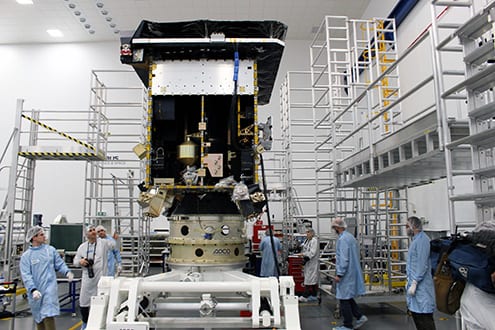
The Solar Orbiter Structural Thermal Model at Airbus Defence & Space in Stevenage. Photo: O. Usher (UCL MAPS)
The STM is a full-scale model of the spacecraft, which is used for extensive pre-flight testing. Its appearance, structure and design are virtually identical to what will launch in 2018 – the main difference is that the delicate (and costly) electronics are replaced by dummy components that mimic their physical size, weight and properties.
The extensive pre-flight testing, covering potential hazards such as vibration, G-forces and heat resistance (crucial for a solar mission) will be carried out on the STM, to identify potential issues with the flight model before it’s too late.
UCL leads the development of two of the scientific instruments that will fly on board Solar Orbiter.

Louise Harra and Chris Owen, both of UCL Mullard Space Science Laboratory, at the Airbus facility in Stevenage. Photo: O. Usher (UCL MAPS)
The Extreme Ultraviolet Imager, with Louise Harra as a co-PI, will image the atmosphere of the Sun, which is heated by our star’s magnetic field. The solar atmosphere is far hotter than the Sun’s surface – an apparent paradox – and Solar Orbiter will aid scientists in their efforts to shed light on precisely why this is.
The Solar Wind Analyser, led by Chris Owen, will study the particles that make up the solar wind. The solar wind is a constant stream of charged particles churned out by the Sun and blown out into the far reaches of the Solar System. It cannot be studied from the ground, as the particles are deflected by the Earth’s magnetic field.
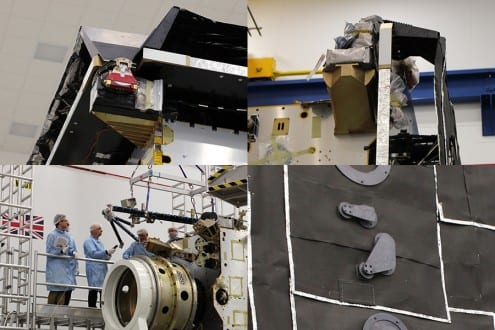
Dummy models of the scientific instruments UCL is contributing to on the Solar Orbiter STM.
Top left: the Solar Wind Analyser Proton-Alpha Sensor
Top right: the Solar Wind Analyser Heavy Ion Sensor
Bottom left: the Solar Wind Analyser Electron Analyser System (on the boom being attached to the spacecraft)
Bottom right: the apertures in the heat shield behind which the Extreme Ultraviolet Imager is located
One of the unique features of Solar Orbiter, over all other solar observation missions to date, is that it will give an unprecedented perspective on the Sun. During its mission, it will use Venus fly-bys, each time getting a small nudge from the planet. This will gradually move Solar Orbiter out of the plane of the Solar System – where Earth and all the other planets lie – and by about six years into the mission, it will be in a position to look down onto the poles of the Sun. These have never been seen before, and they are crucial to understanding the Sun’s magnetic field.
Solar Orbiter will also fly telescopes closer to the Sun than any spacecraft before and be able to observe features such as sunspots evolve for weeks at a time, thanks to an orbit that follows the rotation of the Sun.
Solar Orbiter will fly inside the orbit of Mercury, at barely over a quarter of the Earth’s distance from the Sun. This means extremely powerful Solar radiation, bright light and intense heat. Part of the engineering challenge of building the spacecraft is its heat shield, which protects Solar Orbiter’s delicate electronics, shielding them from temperatures of 600 degrees and keeping the internal temperature down to a much more manageable 60 degrees.
The instruments can poke through small openings in the heat shield so as to observe the Sun’s surface without being fried.
Solar Orbiter is scheduled for launch in 2018. The launch vehicle will be provided by the United States. Like many space missions, this is a project of international cooperation.
Links
Darkness falls across the land
By uccadwl, on 24 March 2015
These two photographs were taken in the quad during the eclipse. The first at 9:25 the second at 9:31am.
During this time the light dropped by a factor of 16: dropping from an Exposure Value (EV) value of 11 to 7, or 4 stops, to the photographers amongst you.
My eyes told me it got “a bit darker”, the reality was far more!
 Close
Close



